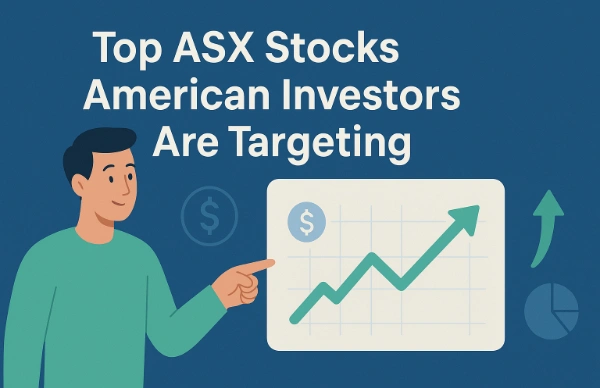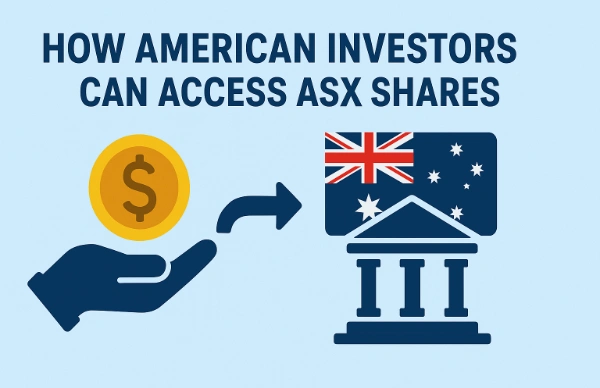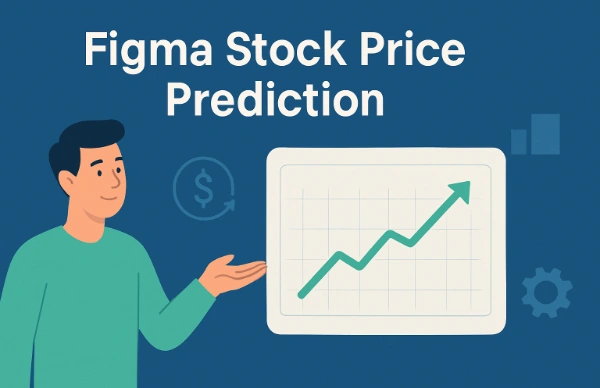In an increasingly interconnected global economy, savvy American investors are expanding their portfolios beyond domestic markets to capture international growth opportunities. One market that’s been gaining significant attention is Australia’s ASX (Australian Securities Exchange), where American investors are turning to Australian ASX shares for growth like never before. This comprehensive guide explores why this trend is accelerating and how you can potentially benefit from investing in Australian stocks.
Table of Contents
The Rising Tide of Cross-Border Investment
The investment landscape has evolved dramatically over the past decade. With technology making international investing more accessible and American investors seeking diversification beyond the saturated U.S. markets, why American investors are turning to Australian ASX shares for growth becomes a compelling story of strategic portfolio management and global opportunity recognition.
Australian markets offer a unique proposition: a developed economy with strong regulatory frameworks, abundant natural resources, and a strategic position in the Asia-Pacific region. For American investors, this represents an opportunity to tap into markets that often move independently of U.S. economic cycles.
Understanding the Australian Securities Exchange (ASX)
What Makes the ASX Attractive to American Investors?

The Australian Securities Exchange stands as the 16th largest stock exchange globally by market capitalization, hosting over 2,000 listed entities. Here’s why American investors are turning to Australian ASX shares for growth:
Market Stability and Regulation Australia maintains one of the world’s most robust regulatory environments for securities trading. The Australian Securities and Investments Commission (ASIC) ensures strict compliance standards that rival or exceed those of the SEC, providing American investors with familiar levels of investor protection.
Economic Resilience Australia has demonstrated remarkable economic stability, avoiding recession for nearly three decades until the COVID-19 pandemic. This track record of consistent growth makes it an attractive destination for American capital seeking stable returns.
Currency Diversification Benefits Investing in ASX shares provides natural hedging against U.S. dollar fluctuations. When the Australian dollar strengthens against the USD, American investors benefit from currency gains in addition to any stock appreciation.
Also read: Best Stock Market Apps in the US for Beginners and Experienced Traders in 2025
Key Sectors Driving American Interest in ASX Shares
Mining and Resources: The Backbone of Australian Growth
| Sector | Market Cap (AUD Billions) | Key Players | Growth Potential |
|---|---|---|---|
| Iron Ore | 180+ | BHP, Rio Tinto, Fortescue | High – Asian demand |
| Gold Mining | 120+ | Newcrest, Evolution Mining | Stable – Safe haven asset |
| Lithium | 45+ | Pilbara Minerals, Allkem | Explosive – EV revolution |
| Coal | 35+ | Whitehaven Coal, Yancoal | Volatile – Energy transition |
The resources sector represents the most compelling reason why American investors are turning to Australian ASX shares for growth. Australia is a global leader in critical mineral production, including:
- Iron Ore: Australia supplies over 60% of global iron ore, primarily to China
- Lithium: Home to some of the world’s largest lithium reserves, crucial for battery technology
- Gold: Third-largest gold producer globally, offering portfolio hedging benefits
- Rare Earths: Emerging as a key alternative to Chinese rare earth supplies
Financial Services: A Mature and Profitable Sector
Australia’s banking sector, dominated by the “Big Four” banks (Commonwealth Bank, ANZ, Westpac, and NAB), offers American investors exposure to a stable financial system with attractive dividend yields often exceeding 4-6% annually.
Why This Matters for American Investors:
- Consistent dividend payments
- Strong regulatory oversight
- Exposure to Asian financial growth through trade finance
- Real estate exposure through mortgage portfolios
Technology and Innovation: The Emerging Growth Story
While traditionally resource-heavy, Australia’s ASX is witnessing significant growth in technology stocks. Companies like Afterpay (now part of Block), Atlassian, and WiseTech Global have demonstrated that Australian tech can compete globally.
Key Technology Trends on the ASX:
- Fintech innovation
- Software-as-a-Service (SaaS) solutions
- Cybersecurity
- Healthcare technology
Economic Factors Fueling American Investment in ASX Shares
Interest Rate Differentials
One crucial factor explaining why American investors are turning to Australian ASX shares for growth is the interest rate environment. Historically, Australia has maintained different monetary policy cycles compared to the United States, creating opportunities for yield-seeking investors.
Trade Relationships and Economic Ties
Australia’s strategic position as a bridge between Western economies and the rapidly growing Asia-Pacific region makes it an ideal proxy for American investors wanting exposure to Asian growth without the political risks associated with direct investment in countries like China.
Resource Demand from Asia
The ongoing urbanization and industrialization across Asia, particularly in India and Southeast Asia, continues to drive demand for Australian commodities. This creates a long-term growth thesis that attracts American institutional investors.
Also read: Lululemon Athletica Inc Stock Price Prediction 2026, 2027, 2030, 2040, 2050
Performance Comparison: ASX vs. U.S. Markets
| Metric | ASX 200 (5-Year) | S&P 500 (5-Year) | Difference |
|---|---|---|---|
| Total Return | 8.2% | 11.7% | -3.5% |
| Dividend Yield | 4.1% | 1.8% | +2.3% |
| Volatility | 16.8% | 18.2% | -1.4% |
| Correlation with US Markets | 0.72 | 1.00 | -0.28 |
Note: Performance data is illustrative and may vary based on specific time periods and market conditions.
While the ASX may not have matched the S&P 500’s capital appreciation in recent years, it offers several compelling advantages:
- Higher Dividend Yields: Australian companies traditionally pay higher dividends
- Lower Volatility: Generally more stable price movements
- Diversification Benefits: Lower correlation with U.S. markets during certain periods
Top ASX Stocks American Investors Are Targeting

Large-Cap Opportunities
BHP Group (BHP) The world’s largest mining company offers American investors direct exposure to global commodity cycles. With operations spanning iron ore, copper, coal, and petroleum, BHP represents a comprehensive play on global industrial demand.
Commonwealth Bank of Australia (CBA) As Australia’s largest bank, CBA provides exposure to the Australian economy’s growth while offering attractive dividend yields. The bank’s digital transformation initiatives position it well for future growth.
CSL Limited (CSL) A global biotechnology company specializing in plasma-derived therapies, CSL offers American investors exposure to healthcare innovation outside traditional U.S. biotech centers.
Mid-Cap Growth Stories
Fortescue Metals Group (FMG) A pure-play iron ore producer with ambitious green hydrogen initiatives, representing both traditional mining exposure and clean energy transition opportunities.
Xero Limited (XRO) A cloud-based accounting software company that competes globally with QuickBooks, offering American investors exposure to SaaS growth in accounting technology.
Also read: American Eagle Outfitters Inc Stock Price Predictions 2026, 2027, 2030, 2040, 2050
How American Investors Can Access ASX Shares

Direct Investment Methods
American Depositary Receipts (ADRs) Many major Australian companies trade as ADRs on U.S. exchanges, providing the easiest access for American investors. Popular ADRs include:
- BHP Group (BHP)
- Rio Tinto (RIO)
- Westpac Banking Corporation (WBK)
International Brokerage Accounts Major U.S. brokers like Charles Schwab, Fidelity, and Interactive Brokers offer direct access to ASX trading, though this may involve additional fees and currency conversion costs.
Indirect Investment Approaches
Exchange-Traded Funds (ETFs) Several ETFs provide broad exposure to Australian markets:
- iShares MSCI Australia ETF (EWA)
- VanEck Vectors Australia Equal Weight ETF (MVA)
- Franklin FTSE Australia ETF (FLAU)
Mutual Funds International mutual funds often include Australian holdings as part of broader Asia-Pacific or international equity strategies.
Tax Implications for American Investors
Understanding the Tax Treaty
The U.S.-Australia Tax Treaty provides important benefits for American investors in ASX shares:
Dividend Withholding Tax
- Standard Australian withholding tax: 30%
- Treaty rate for U.S. investors: 15%
- Potential for further reduction through franking credits
Capital Gains Treatment
- No Australian capital gains tax for non-resident investors on most share sales
- U.S. tax applies based on standard capital gains rules
Franking Credits: A Unique Australian Advantage
Australia’s dividend imputation system allows companies to pass tax credits to shareholders. While American investors can’t directly benefit from franking credits, they often translate into higher dividend payments.
Also read: Figma Stock Price Prediction 2026, 2027, 2030, 2040, 2050
Risks and Considerations for American Investors
Currency Risk Management
Exchange Rate Volatility The AUD/USD exchange rate can significantly impact returns for American investors. Historical volatility ranges of 20-30% annually require careful consideration.
Hedging Strategies
- Currency-hedged ETFs
- Forward contracts
- Natural hedging through diversified currency exposure
Market-Specific Risks
Commodity Price Dependency Australia’s market correlation with commodity prices means American investors gain exposure to global supply and demand dynamics for raw materials.
Geographic Concentration Heavy weighting toward resources and financials creates sector concentration risk that American investors should balance against their existing holdings.
Regulatory and Political Considerations
Foreign Investment Review Board (FIRB) While generally welcoming to foreign investment, Australia maintains oversight mechanisms that could potentially impact large investments.
U.S. Regulatory Compliance American investors must ensure compliance with U.S. reporting requirements for foreign investments, including potential FBAR and Form 8938 obligations.
Market Timing and Strategy Considerations
Economic Cycles and Market Timing
Understanding why American investors are turning to Australian ASX shares for growth requires recognizing the cyclical nature of both economies. Optimal timing often involves:
Commodity Cycle Analysis
- Monitoring global supply and demand for key resources
- Understanding Chinese economic policies and growth projections
- Tracking infrastructure spending across Asia-Pacific
Interest Rate Cycles
- Analyzing Reserve Bank of Australia policy directions
- Comparing yield differentials with U.S. Treasury securities
- Assessing currency implications of rate differentials
Portfolio Integration Strategies
Core-Satellite Approach Many American investors use Australian ASX shares as satellite holdings (5-15% of portfolio) to complement core U.S. holdings.
Sector-Specific Exposure Targeting specific sectors like mining or healthcare where Australia offers unique opportunities not available in U.S. markets.
Future Outlook: Why the Trend Will Continue
Demographic and Economic Drivers
Asian Economic Growth Continued urbanization and middle-class expansion across Asia supports long-term demand for Australian commodities and services.
Clean Energy Transition Australia’s abundance of critical minerals for renewable energy and battery technology positions it as a key beneficiary of global energy transition.
Technology Sector Development Growing recognition of Australian technology capabilities, particularly in fintech and software services, attracts growth-oriented American investors.
Structural Changes Supporting Investment
Improved Market Access Technology improvements and regulatory harmonization continue to reduce barriers for American investors accessing ASX shares.
Enhanced Corporate Governance Australian companies increasingly adopt international best practices, making them more attractive to institutional American investors.
Also read: CRM Stock Price Prediction 2026, 2027, 2030, 2040, 2050
Investment Strategies and Best Practices
Dollar-Cost Averaging into ASX Positions
Given currency volatility and market cycles, many successful American investors employ dollar-cost averaging when building ASX positions. This strategy helps smooth out both market timing and currency conversion impacts.
Sector Rotation Strategies
Resource Cycle Management
- Early cycle: Focus on exploration and development companies
- Mid-cycle: Shift to established producers
- Late cycle: Consider defensive positions or profit-taking
Dividend Harvesting Timing investments around Australian dividend payment seasons (typically February and August) can optimize income for American investors seeking yield.
Risk Management Framework
| Risk Type | Mitigation Strategy | Implementation |
|---|---|---|
| Currency Risk | Partial hedging | Currency ETFs, forwards |
| Sector Concentration | Diversification | Multiple sectors/geographies |
| Liquidity Risk | Position sizing | Limit individual positions |
| Regulatory Risk | Due diligence | Stay informed on policy changes |
Technology and Platform Considerations
Trading Platforms for American Investors
Full-Service International Brokers
- Interactive Brokers: Competitive rates, direct market access
- Charles Schwab International: Comprehensive research tools
- Fidelity International: Strong customer service
Specialized Platforms
- Stake: Focused on Australian market access for international investors
- CommSec International: Commonwealth Bank’s platform for overseas investors
Research and Analysis Tools
American investors benefit from utilizing both U.S. and Australian research sources:
- Morningstar Australia for fundamental analysis
- Bell Potter and Macquarie research for local insights
- Bloomberg Terminal for institutional-grade data
Also read: Microsoft Stock Price Prediction 2026, 2027, 2030, 2040, 2050
Environmental, Social, and Governance (ESG) Considerations
ESG Trends in Australian Markets
The ASX has seen significant growth in ESG-focused investing, driven by:
- Climate change awareness and carbon reduction commitments
- Indigenous rights and reconciliation initiatives
- Board diversity and corporate governance improvements
ESG Leaders on the ASX:
- Fortescue Metals Group (green hydrogen initiatives)
- CSL Limited (healthcare access programs)
- Woolworths Group (sustainable retail practices)
Impact on American Investment Decisions
American investors increasingly factor ESG considerations into their ASX investments, particularly given Australia’s role in global climate change discussions and natural resource stewardship.
Sector Deep Dive: Mining and Resources
The Commodity Supercycle Thesis
Many analysts believe we’re entering a new commodity supercycle driven by:
- Global infrastructure spending
- Energy transition material demands
- Supply chain reshoring initiatives
- Emerging market development
Key Investment Implications:
- Higher sustainable commodity prices
- Increased capital expenditure in mining
- Premium valuations for quality assets
- Enhanced dividend sustainability
Innovation in Australian Mining
Technology Adoption:
- Autonomous mining operations
- Artificial intelligence in exploration
- Sustainable mining practices
- Digital twin technology implementation
These innovations position Australian miners as global leaders, attracting American investors seeking exposure to modernizing industrial sectors.
Financial Services Sector Analysis
Banking Sector Fundamentals
Australian banks offer American investors several unique advantages:
Strong Capital Ratios
- Tier 1 capital ratios typically exceed global banking averages
- Conservative lending practices following global financial crisis lessons
- Robust stress testing and regulatory oversight
Dividend Sustainability
- Payout ratios generally range from 60-80% of earnings
- Franking benefits enhance effective yields
- Consistent payment history even during economic downturns
Emerging Fintech Opportunities
Australia’s fintech sector has produced global success stories, offering American investors early-stage growth opportunities in:
- Buy-now-pay-later services
- Digital banking solutions
- Cryptocurrency and blockchain technology
- Insurance technology (InsurTech)
Also read: Top U.S. Blockchain Companies to Watch in 2025
Healthcare and Biotechnology on the ASX
Global Competitive Advantages
Australian healthcare companies benefit from:
- Strong research and development ecosystem
- Government support for medical innovation
- Strategic partnerships with Asian markets
- Cost-competitive clinical trial environment
Key Players Attracting American Investment:
- CSL Limited: Global plasma therapies leader
- Cochlear Limited: Hearing implant technology
- ResMed Inc.: Sleep disorder treatment devices
- Sonic Healthcare: Pathology and diagnostic services
Regulatory Environment
Australia’s Therapeutic Goods Administration (TGA) maintains high standards while often providing faster approval pathways than the FDA for certain treatments, creating potential first-mover advantages for Australian biotechnology companies.
Real Estate Investment Trusts (REITs) on the ASX
REIT Sector Overview
Australian REITs (A-REITs) provide American investors with exposure to:
- Commercial real estate in major Australian cities
- Industrial and logistics properties
- Retail centers and shopping complexes
- Specialized healthcare and aged care facilities
Dividend Characteristics
A-REITs typically distribute 80-100% of their distributable income, offering American investors:
- Higher yields than comparable U.S. REITs
- Quarterly distribution schedules
- Exposure to Australian property cycles
- Currency diversification benefits
Technology Sector Growth Opportunities
Software and Services
Global Success Stories:
- Atlassian Corporation: Collaboration software
- WiseTech Global: Logistics software solutions
- Technology One: Enterprise resource planning
- Xero Limited: Cloud accounting software
These companies demonstrate Australia’s capability to develop globally competitive technology solutions, attracting American investors seeking international tech exposure.
Emerging Technology Themes
Cybersecurity: Australian companies are developing innovative cybersecurity solutions, driven by increasing global demand for digital security.
AgriTech: Combining Australia’s agricultural expertise with technology innovation creates opportunities in precision farming and food security solutions.
Infrastructure and Utilities Investment
Essential Services Exposure
Australian infrastructure stocks provide American investors with exposure to:
- Toll road operators (Transurban Group)
- Airport services (Sydney Airport, Melbourne Airport)
- Utilities (AGL Energy, Origin Energy)
- Telecommunications (Telstra Corporation)
Inflation Protection Characteristics
Many Australian infrastructure investments offer:
- Revenue linked to inflation indices
- Essential service demand patterns
- Regulated return frameworks
- Long-term contract structures
Consumer Discretionary and Staples
Retail and Consumer Trends
Major Retail Players:
- Woolworths Group: Supermarket and retail giant
- Coles Group: Major supermarket chain
- JB Hi-Fi: Electronics and entertainment retailer
- Harvey Norman: Furniture and electronics
Demographic Trends Supporting Growth
Australia’s growing population, urbanization trends, and increasing Asian tourism (post-pandemic recovery) support consumer-focused investments.
Practical Implementation Guide
Getting Started: A Step-by-Step Approach
Phase 1: Research and Education (Months 1-2)
- Open international trading account with chosen broker
- Research major ASX indices and sector weightings
- Understand Australian tax implications and treaty benefits
- Identify initial target allocation (typically 5-15% of portfolio)
Phase 2: Initial Investment (Months 3-4)
- Start with broad market ETF exposure
- Begin dollar-cost averaging approach
- Monitor currency exchange rates and timing
- Track performance against benchmarks
Phase 3: Selective Stock Picking (Months 5-12)
- Research individual companies based on investment thesis
- Diversify across sectors and market capitalizations
- Consider dividend payment schedules for income optimization
- Implement risk management strategies
Portfolio Construction Examples
Conservative Approach (60% Defensive, 40% Growth):
- 30% ASX financials (major banks)
- 30% ASX utilities and infrastructure
- 25% ASX resources (diversified miners)
- 15% ASX healthcare and consumer staples
Growth-Oriented Approach (30% Defensive, 70% Growth):
- 35% ASX technology and growth stocks
- 25% ASX resources and materials
- 20% ASX small and mid-cap growth
- 20% ASX REITs and financials
Balanced Approach (50% Defensive, 50% Growth):
- 25% ASX financials
- 25% ASX resources
- 20% ASX technology and healthcare
- 15% ASX infrastructure
- 15% ASX consumer and retail
Monitoring and Performance Evaluation
Key Performance Indicators
Total Return Metrics:
- Capital appreciation in AUD terms
- Currency impact on USD returns
- Dividend income and yield
- Risk-adjusted returns (Sharpe ratio)
Portfolio Health Indicators:
- Sector diversification maintenance
- Correlation with U.S. holdings
- Volatility patterns
- Liquidity considerations
Rebalancing Strategies
Time-Based Rebalancing:
- Quarterly assessment of sector weightings
- Annual review of individual holdings
- Semi-annual currency impact evaluation
Threshold-Based Rebalancing:
- Rebalance when sectors drift >5% from target
- Currency hedge adjustments at 10% moves
- Individual position limits at 8-10% of ASX allocation
Common Mistakes to Avoid
Over-Concentration in Resources
While Australia’s resource sector offers attractive opportunities, American investors should avoid over-concentration. Diversification across sectors reduces commodity price sensitivity.
Ignoring Currency Hedging
Currency movements can significantly impact returns. Consider partial hedging strategies, especially for larger allocations to ASX shares.
Timing the Market Based on Commodity Cycles
Attempting to perfectly time commodity cycles often leads to suboptimal returns. Focus on long-term trends rather than short-term price movements.
Neglecting Tax Planning
Understanding the interaction between Australian withholding taxes and U.S. tax obligations is crucial for optimizing after-tax returns.
Future Trends and Considerations
Evolving Market Structure
Technology Integration:
- Increased algorithmic trading
- Real-time settlement systems
- Enhanced market data accessibility
- Improved price discovery mechanisms
Regulatory Evolution:
- Harmonization with global standards
- Enhanced disclosure requirements
- Strengthened investor protections
- Cross-border regulatory cooperation
Emerging Investment Themes
Clean Energy Transition: Australia’s renewable energy potential and critical mineral resources position it as a key beneficiary of global decarbonization efforts.
Digital Economy Growth: Expansion of digital services and e-commerce creates opportunities in technology infrastructure and platform companies.
Healthcare Innovation: Aging populations and medical technology advances support growth in Australian healthcare and biotechnology sectors.
Conclusion: The Strategic Case for ASX Investment
Why American investors are turning to Australian ASX shares for growth reflects a sophisticated understanding of global portfolio optimization. The Australian market offers unique characteristics that complement U.S. investments:
- Diversification Benefits: Lower correlation with U.S. markets during many periods
- Sector Exposure: Access to resources and materials not readily available in U.S. markets
- Dividend Income: Higher yielding stocks with tax-efficient structures
- Currency Diversification: Natural hedge against U.S. dollar weakness
- Growth Exposure: Participation in Asia-Pacific economic expansion
The trend toward international diversification, combined with Australia’s strong regulatory environment and economic fundamentals, suggests this investment theme will continue growing. American investors who understand the opportunities and risks can potentially enhance their portfolio returns while reducing overall portfolio risk through strategic ASX exposure.
Success in ASX investing requires careful research, appropriate risk management, and a long-term perspective. By understanding the unique characteristics of Australian markets and implementing thoughtful investment strategies, American investors can potentially benefit from the growth opportunities that Australian ASX shares provide.
Frequently Asked Questions
What is the minimum investment required for American investors to buy ASX shares?
There’s no official minimum, but practical considerations suggest starting with at least $5,000-$10,000 to justify international transaction costs. Many brokers charge $15-$50 per international trade, making smaller investments cost-prohibitive.
How do I convert USD to AUD for ASX investments?
Most international brokers automatically handle currency conversion at competitive rates. You can also use specialized foreign exchange services for larger transactions to potentially secure better rates.
Can I buy ASX shares through my existing U.S. brokerage account?
Many major U.S. brokers (Charles Schwab, Fidelity, Interactive Brokers) offer international trading capabilities, but you’ll need to enable this feature and may face additional fees.
What are the trading hours for the ASX from an American perspective?
The ASX typically operates from 6:00 PM to 12:00 AM Eastern Time (due to time zone differences), allowing American investors to trade outside normal U.S. market hours.
How liquid are ASX shares compared to U.S. stocks?
Major ASX stocks generally offer good liquidity, though it’s typically lower than large-cap U.S. stocks. The ASX 200 companies usually have sufficient trading volume for retail investors.





